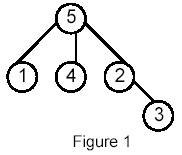POJ——T 1470 Closest Common Ancestors
http://poj.org/problem?id=1470
| Time Limit: 2000MS | Memory Limit: 10000K | |
| Total Submissions: 20830 | Accepted: 6617 |
Description
Input
nr_of_vertices
vertex:(nr_of_successors) successor1 successor2 ... successorn
...
where vertices are represented as integers from 1 to n ( n <= 900 ). The tree description is followed by a list of pairs of vertices, in the form:
nr_of_pairs
(u v) (x y) ...
The input file contents several data sets (at least one).
Note that white-spaces (tabs, spaces and line breaks) can be used freely in the input.
Output
For example, for the following tree:

Sample Input
5
5:(3) 1 4 2
1:(0)
4:(0)
2:(1) 3
3:(0)
6
(1 5) (1 4) (4 2)
(2 3)
(1 3) (4 3)
Sample Output
2:1
5:5
Hint
Source
#include <algorithm>
#include <cstring>
#include <cstdio> using namespace std; const int N(2e5+);
int n,m,cnt;
int ans[N]; int head[N],sumedge;
struct Edge
{
int v,next;
Edge(int v=,int next=):
v(v),next(next){}
}edge[N<<];
inline void ins(int u,int v)
{
edge[++sumedge]=Edge(v,head[u]);
head[u]=sumedge;
} int son[N],size[N],deep[N],top[N],dad[N],fa[N];
void DFS(int u,int fa,int deepth)
{
size[u]=;
dad[u]=fa;
deep[u]=deepth;
for(int v,i=head[u];i;i=edge[i].next)
{
v=edge[i].v;
if(dad[u]==v) continue;
DFS(v,u,deepth+);
size[u]+=size[v];
if(size[son[u]]<size[v]) son[u]=v;
}
}
void DFS_(int u,int Top)
{
top[u]=Top;
if(son[u]) DFS_(son[u],Top);
for(int v,i=head[u];i;i=edge[i].next)
{
v=edge[i].v;
if(dad[u]!=v&&son[u]!=v) DFS_(v,v);
}
}
int LCA(int x,int y)
{
for(;top[x]!=top[y];x=dad[top[x]])
if(deep[top[x]]<deep[top[y]]) swap(x,y);
return deep[x]<deep[y]?x:y;
} inline void init()
{
sumedge=;
memset(fa,,sizeof(fa));
memset(dad,,sizeof(dad));
memset(top,,sizeof(top));
memset(son,,sizeof(son));
memset(ans,,sizeof(ans));
memset(size,,sizeof(size));
memset(head,,sizeof(head));
memset(edge,,sizeof(edge));
memset(deep,,sizeof(deep));
} inline void read(int &x)
{
x=;register char ch=getchar();
for(;ch<''||ch>'';) ch=getchar();
for(;ch>=''&&ch<='';ch=getchar()) x=x*+ch-'';
} int main()
{
for(int t;~scanf("%d",&t);init())
{
n=t;
for(int u,v,nn;t--;)
{
read(u);
read(nn);
for(int i=;i<=nn;i++)
{
read(v);
fa[v]=u;
ins(u,v);
ins(v,u);
}
}
int root=;
for(;root<=n;root++)
if(!fa[root]) break;
DFS(root,,);
DFS_(root,root);
read(m);
for(int u,v;m--;)
{
read(u),read(v);
ans[LCA(u,v)]++;
}
for(int i=;i<=n;i++)
if(ans[i]) printf("%d:%d\n",i,ans[i]);
}
return ;
}
POJ——T 1470 Closest Common Ancestors的更多相关文章
- POJ 1470 Closest Common Ancestors(最近公共祖先 LCA)
POJ 1470 Closest Common Ancestors(最近公共祖先 LCA) Description Write a program that takes as input a root ...
- POJ 1470 Closest Common Ancestors 【LCA】
任意门:http://poj.org/problem?id=1470 Closest Common Ancestors Time Limit: 2000MS Memory Limit: 10000 ...
- POJ 1470 Closest Common Ancestors (LCA,离线Tarjan算法)
Closest Common Ancestors Time Limit: 2000MS Memory Limit: 10000K Total Submissions: 13372 Accept ...
- POJ 1470 Closest Common Ancestors
传送门 Closest Common Ancestors Time Limit: 2000MS Memory Limit: 10000K Total Submissions: 17306 Ac ...
- POJ 1470 Closest Common Ancestors (LCA, dfs+ST在线算法)
Closest Common Ancestors Time Limit: 2000MS Memory Limit: 10000K Total Submissions: 13370 Accept ...
- poj——1470 Closest Common Ancestors
Closest Common Ancestors Time Limit: 2000MS Memory Limit: 10000K Total Submissions: 20804 Accept ...
- poj 1470 Closest Common Ancestors LCA
题目链接:http://poj.org/problem?id=1470 Write a program that takes as input a rooted tree and a list of ...
- POJ 1470 Closest Common Ancestors【近期公共祖先LCA】
版权声明:本文为博主原创文章,未经博主同意不得转载. https://blog.csdn.net/u013912596/article/details/35311489 题目链接:http://poj ...
- POJ 1470 Closest Common Ancestors【LCA Tarjan】
题目链接: http://poj.org/problem?id=1470 题意: 给定若干有向边,构成有根数,给定若干查询,求每个查询的结点的LCA出现次数. 分析: 还是很裸的tarjan的LCA. ...
随机推荐
- ASP.NET 让ajax请求webform后台方法
$.ajax({ type: "POST", url: ".aspx/getSubjectDirection", data: JSON.stringify({ ...
- 使用rman恢复数据小结
恢复前提有数据备份 以 alter database open resetlogs 开机以后多要做一次全备(以前的备份失效了) 恢复参数文件: restore spfile from '/home/o ...
- Swift 中的协议
Swift 中的协议协议是为方法.属性等定义一套规范,没有具体的实现,类似于Java中的抽象接口,它只是描述了方法或属性的骨架,而不是实现.方法和属性实现还需要通过定义类,函数和枚举完成. 协议定义 ...
- Python3基础笔记---序列化
1.json模块 菜鸟教程 JSON(JavaScript Object Notation) 是一种轻量级的数据交换格式,易于人阅读和编写. import json json.dumps json ...
- Linux停止tomcat运行
打开终端cd /java/tomcat#执行bin/startup.sh #启动tomcatbin/shutdown.sh #停止tomcattail -f logs/catalina.out #看t ...
- useradd: cannot open /etc/passwd
[root@ftp ~]# useradd -g ftp -s/sbin/nologin liwmuseradd: cannot open /etc/passwd [root@ftp ~]# user ...
- (51) magento集成增加到款通知
这篇主要讲述如何二开增加自己的功能,我没有继承方式二开,习惯是不好的,直接改了原来的模块. 达到效果就这样,当在网站支付成功,会同步到ERP系统中.下面来讲述实现过程 建立文件 payment_not ...
- pandas 7 合并 merge 水平合并,数据会变宽
pd.merge( df1, df2, on=['key1', 'key2'], left_index=True, right_index=True, how=['left', 'right', 'o ...
- SQL的四种语言:DDL、DML、DCL、TCL
1. DDL(Data Definition Language) 数据库定义语言statements are used to define the database structure or sche ...
- HDOJ 题目1520 Anniversary party(树形dp)
Anniversary party Time Limit: 2000/1000 MS (Java/Others) Memory Limit: 65536/32768 K (Java/Others ...
